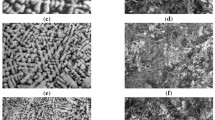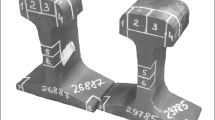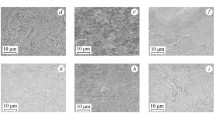The properties of railroad rails produced from bainitic steels are compared to those from traditional pearlitic steels. Formation and propagation of contact fatigue cracks in the rails is considered. It is shown that bainitic steels exhibit a better combination of strength and ductility characteristics than pearlitic steels.









Similar content being viewed by others
References
M. Georgiev, Crack Resistance of Railway Rails [in Russian], Master-flag, Kemerovo (2006), 212 p.
V. V. Pavlov, M. V. Temlyantsev, L. V. Korneva, and A. Yu. Sosyukin, Advanced Processes of Heat and Thermomechanical Treatment in the Production of Rails [in Russian], Teplotekhnik (2007), 279 p.
Rail Defects. Classification, Catalogue and Parameters of Defective and Highly Defective Rails. Instruction [in Russian], adopted by OAO “RZhD” 23.10.2014.
M. L. Bernshtein and A. G. Rakhshtadt (eds.), Metal Science and Heat Treatment of Steel, Vol. III: Heat Treatment of Metal Products [in Russian], Metallurgiya, Moscow (1983), 216 p.
E. Magel, P. Sroba, K. Sawley, and J. Kalousek, “Control of rolling contact fatigue of rails,” in: Proc. AREMA 2004 Annual Conf., Spt. 19 – 22, 2004, Nashville, Tennessee.
M. Vidaud and W. Zwanenburg, “Current situation on rolling contact fatigue—a rail wear phenomenon,” Conf. Paper STRC (2009).
A. E. Chard, Deformation of Inclusions in Rail Steel Due to Rolling Contact, M. Res. Thesis, University of Birmingham (2012).
V. V. Polyakov and A. V. Velikanov, Fundamentals of the Production of Railway Rails [in Russian], Metallurgiya, Moscow (1990), p. 416.
H. A. Aglan, Z. Y. Liu, M. F. Hassan, and M. Fateh, “Mechanical and fracture behavior of bainitic rail steel,” J. Mater Proc. Technol., 151, 268 – 274 (2004).
H. A. Aglan and M. Fateh, “Microstructure-fatigue crack propagation kinetics relationships of rail steels,” J. Civil Eng. Architect., 4(9) (Ser. No. 34), ISSN 1934-7359, USA.
H. A. Aglan, “Fatigue crack growth and fracture behavior of bainitic rail steels,” in: Tech. Report DTFR53-02-G-00021 (2011).
H. A. Aglan and M. Fateh, “Fracture and fatigue crack growth analysis of rail steels,” J. Mech. Mater. Struct., 2(2), 335 – 346 (2007).
M. Fateh, “Fracture and fatigue damage tolerance of bainitic and pearlitic rail steels,” in: U.S. Dept. of Transportation, Federal Road Administration, Research Results, Issue No. RR06-02, Feb. 2006, 4 p. (https://www.fra.dot.gov/Elib/Document/2136).
“Steels for rails of high-speed lines,” Zhelez. Dor. Mira, No. 8, 67 – 70 (2000).
Y. Satoh, M. Tatsumi, K. Kasiwaya, et al., “Development of anti-dark spot bainitic steel rail,” QR of RTRI, 40(2), 86 – 91 (1999).
G. Girsch and R. Heyder, “Advanced pearlitic and bainitic high strength rails promise to improve rolling contact fatigue resistance,” in: Proc. 7th World Cong. on Railway Research (WCRR2006), Montreal, Canada, June 4 – 8, 2006 (https://uic.org/cdrom/2006/wcrr2006/pdf/712.pdf).
G. Girsch, N. Frank, P. Pointer, and R. Stock, “Life cycle cost considerations on high strength rail steels,” in: Proc. 8th World Cong. on Railway Research (WCRR2008), Seoul, Korea, May 18 – 22, 2008 (https://uic.org/cdrom/2008/11_wcrr2008/pdf/I.2.2.1.1.pdf).
N. Frank, “Developing maintenance free rails,” Int. Railway J., 28 Nov. (2012).
R. Stock and A. Jörg, “Towards a maintenance free trail,” in: Wheel Rail Interaction Conf. WRI 2013, Heavy Haul Seminar, 8 – 9 May, 2013, Chicago (https://www.wheel-rail-seminars.com/us/downloads.php).
P. Pointer, “High strength rail steels—The importance of material properties in contact mechanics problems,” Wear, 265, 1373 – 1379 (2008).
Author information
Authors and Affiliations
Corresponding author
Additional information
Translated from Metallovedenie i Termicheskaya Obrabotka Metallov, No. 7, pp. 54 – 61, July, 2018.
Rights and permissions
About this article
Cite this article
Georgiev, M.N., Simeonova, T.V. Railroad Rails from Bainitic Steel. Met Sci Heat Treat 60, 464–470 (2018). https://doi.org/10.1007/s11041-018-0302-6
Published:
Issue Date:
DOI: https://doi.org/10.1007/s11041-018-0302-6




